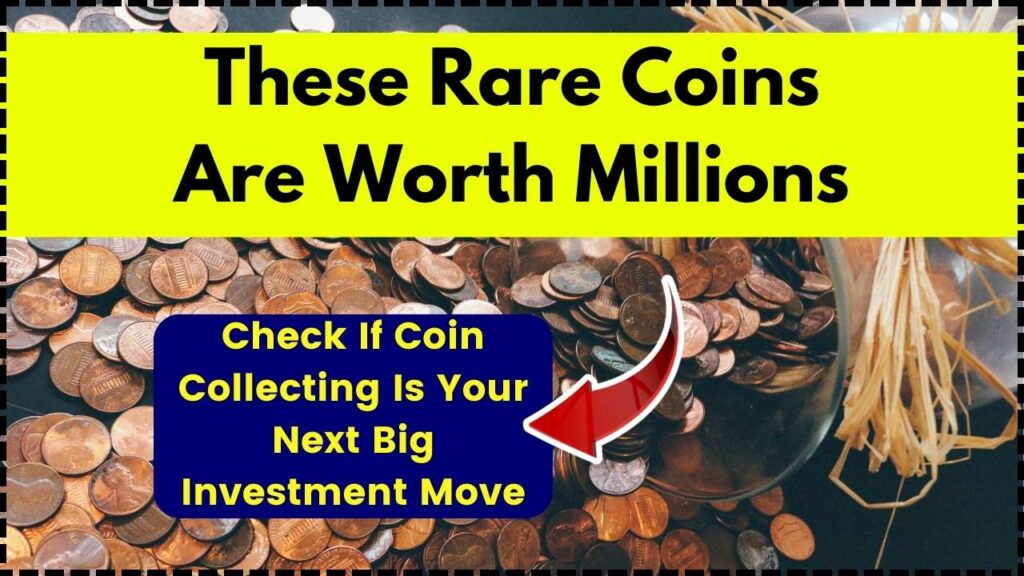
These Rare Coins Are Worth Millions: If you’ve ever stared at the change in your pocket and thought, “Could this be worth more than just a few bucks?”—you’re not crazy. Coin collecting, or numismatics, has been quietly gaining traction not just as a hobby, but as a serious investment strategy. With some rare coins selling for over $18 million, this is no longer just your granddad’s pastime—this is a game for smart investors. So whether you’re a collector, a history buff, or someone looking for a unique way to diversify your portfolio, this guide is going to show you why coin collecting could be your next big investment move—and how to get started the right way.
These Rare Coins Are Worth Millions
Rare coin collecting has evolved from a backroom hobby into a front-row investment opportunity. Whether you’re in it for the thrill of the hunt, the historical charm, or the long-term gains, coins can offer a safe, diversified, and even emotional addition to your portfolio. You don’t need to be rich or a history professor to get started—just curious, patient, and ready to learn. So, before you cash in that pocket change, take a closer look. You might just be holding your first million-dollar coin.
| Topic | Details |
|---|---|
| Top-Selling Coin | 1933 Double Eagle Gold Coin – Sold for $18.9 million |
| Other Notable Coins | 1794 Flowing Hair Silver Dollar ($10M), 1913 Liberty Head Nickel ($4.5M), 1894-S Barber Dime ($2M) |
| Key Value Factors | Rarity, Historical Context, Coin Grade, Demand |
| Investor Profile | Hobbyists, Collectors, Wealth Managers, Hedge Funds |
| Risks | Counterfeits, Illiquidity, Market Knowledge Requirement |
| Resources | U.S. Mint |
Why These Rare Coins Are Worth Millions?
The value of a coin comes down to a few key factors: rarity, demand, historical importance, and condition. Coins aren’t printed forever, and when a particular minting run is extremely limited—or canceled altogether—that scarcity drives up value.
Let’s break down a few examples that prove just how serious this can get:
- 1933 Double Eagle Gold Coin: Originally struck by the U.S. Mint, but never released into circulation due to President Roosevelt ending the gold standard. One sold at auction for $18.9 million in 2021, setting the world record.
- 1794 Flowing Hair Silver Dollar: This was one of the first silver dollars minted by the U.S. A collector paid $10 million in 2013 for a pristine version.
- 1913 Liberty Head Nickel: Only five of these exist, and one sold for $4.5 million.
- 1894-S Barber Dime: A dime so rare that only 9 are known to still exist today. In 2016, one fetched nearly $2 million.
These coins aren’t just rare—they’re relics of America’s economic, political, and cultural history.
The Historical and Economic Context of Coin Collecting
Coins tell stories. Whether it’s a wartime minting error, a gold coin made during the California Gold Rush, or a presidential commemorative edition, these small objects pack a historical punch.
But beyond history, rare coins have caught the eye of wealth advisors and institutional investors because they:
- Offer a hedge against inflation
- Provide a non-correlated asset class (i.e., they don’t rise and fall with the stock market)
- Are tangible assets, which adds a layer of psychological comfort
According to the Knight Frank Luxury Investment Index, rare coins appreciated by over 175% in value between 2011 and 2021—outpacing wine, watches, and even real estate in some years.
What Makes a Coin Valuable?
Rarity
If only a handful of coins were ever minted—or survived—demand will usually skyrocket. The fewer there are, the more collectors are willing to pay.
Grade (Condition)
Coins are graded from 1 to 70 using the Sheldon Scale. Higher numbers equal better preservation. A difference of just one grade can mean thousands—or millions—of dollars in value.
Metal Content
Coins made of gold, silver, or platinum have an inherent material value. These precious metals hold strong even during economic downturns.
Historical Relevance
Coins minted during major events (e.g., Civil War, the Great Depression) or featuring rare design changes often hold more appeal.
Collector Demand
Some coins become famous due to media attention, scarcity rumors, or unique aesthetics. This hype drives prices up fast.
Should You Invest in Rare Coins?
Absolutely—but with caution and preparation.
Pros
- Inflation-resistant asset
- Portable and tangible
- Potential for high long-term returns
- Collectible with emotional/historical value
- Estate planning benefit – easily passed on to heirs
Cons
- Not highly liquid – you can’t cash out instantly
- Requires research and due diligence
- Susceptible to counterfeits
- Storage and insurance costs
How to Start Coin Collecting: A Step-by-Step Beginner’s Guide
Step 1: Educate Yourself
Start with trustworthy sources:
- U.S. Mint’s Educational Resources
- American Numismatic Association (ANA)
- “A Guide Book of United States Coins” (The Red Book)
Step 2: Define Your Focus
Some people collect by era (e.g., colonial coins), by type (Lincoln pennies, Buffalo nickels), or by error coins (double die strikes). Pick a niche and study it deeply.
Step 3: Start Small
You don’t need a fortune to begin. Many coins under $100 today have good upside potential. Visit:
- Local coin shops
- Coin shows
- Online marketplaces like Heritage Auctions and GreatCollections
Step 4: Use Grading Services
Don’t buy expensive coins that haven’t been authenticated and graded by professionals like PCGS or NGC.
Step 5: Store Coins Safely
Improper storage can ruin a coin’s value. Use:
- Mylar flips or capsules
- Humidity-controlled safes
- No direct handling—wear gloves!
Step 6: Monitor the Market
Follow trends on websites like:
- Numismatic News
- CoinWeek
- PCGS Price Guide
Case Study: Turning Pocket Change Into Profits
A New Jersey man found a 1943 bronze Lincoln cent in his grandfather’s collection—a coin that wasn’t supposed to exist. After professional grading, it sold for $204,000 at auction.
Another collector bought a 1969-S Doubled Die Penny for $10 at a flea market. It turned out to be worth $35,000.
Moral of the story? Don’t overlook the coins you already have.
Frequently Asked Questions
Q: Can I really find valuable coins in circulation today?
Yes! Error coins, old silver coins, and certain limited mintage releases can still pop up in everyday change. Always check your pennies and quarters.
Q: What coins should beginners look for?
Start with affordable yet potentially valuable coins, like wheat pennies, buffalo nickels, or modern error coins.
Q: How do I spot a fake coin?
Fake coins may have incorrect weight, detail, or metal content. Always buy from certified dealers and use PCGS/NGC-graded coins.
Q: Is coin collecting taxed?
Yes. In the U.S., profits from selling coins are subject to capital gains tax.
Q: Can I include rare coins in my retirement portfolio?
Yes. Self-directed IRAs can hold physical coins, but they must meet IRS standards. Stick to bullion coins like American Eagles.





